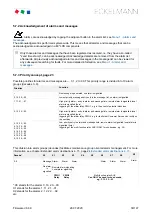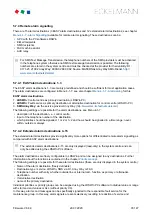
Firmware V6.6.9
29.07.2020
34/147
Up to 14 different PCs can be configured as fault signal receivers in the controller. The requirement for remote
alarm signalling is that the LDSWin PC software is being used on the PCs.
5.7.8 Service Mode
During maintenance or service work on refrigeration pack systems, a series of alarms and messages is tripped
whose forwarding to a control centre or fault service is not required. The controller can be put into the Service
Mode for this purpose. During this time, any remote alarm signalling is suppressed for a specified time.
The submenu for activation of "Service Mode" is called using this button (see chapter
Suppression of the remote alarm signalling
The time period (1..255 minutes) after which the suppression of the remote alarm signalling should be
automatically revoked can be selected in the submenu.
If alarms are generated during the time of the activated service mode, these are entered normally in the alarm
and messages lists of the controller and operator terminal (if available). However, the horn, buzzer and alarm
relays remain deactivated and no automatic transmission of alarms is triggered. In addition, no alarms are sent
to any user PC in the installation connected by direct coupling, modem, LAN gateway, Combi Gateway or CAN
bus – PC adapter.
5.7.9 CAN bus station monitoring
The controller cyclically checks the presence of all E*LDS components once they have been detected in the
system. If any component fails, this is detected by the station monitoring and the error message
"Computer
failure xxx"
is generated. Each new E*LDS component connected to the CAN bus is detected automatically by
the controller using "plug and play" and included in the station monitoring (Menu 2).
The following CAN bus nodes can be present in the E*LDS system:
Risk of the failure of alarm messages via SMS and thus no alarm signalling in the event of
problems!
It
cannot be ensured
that the SMS is delivered securely and promptly to the recipient,
therefore transmission of SMS messages should not be configured as the only alarm path! It is also
possible that a network operator or mobile telephone service provider can change its dial-up number or
its dial-up procedure from time to time, thus generating
significant additional costs
. Precise
information can be obtained from the respective mobile telephone service provider.
In order to monitor the reliable operation of the automatic transmission of alarms, the message path
must be checked regularly using the
check store computer
function provided by the LDSWin PC
software.
The Service Mode can only be activated / deactivated while logged in (store is then unlocked)! The
activation and deactivation of the Service Mode are logged in the message list and also sent to all
available operator terminals in the E*LDS system. The Service Mode can be revoked at any time by
setting the time period to "0" minutes.
If there are still unacknowledged alarms in the alarm list after the time of the Service Mode has
elapsed, the audible warning devices and the alarm relays are activated and the alarms are forwarded
using the automatic transmission of alarms!
















































